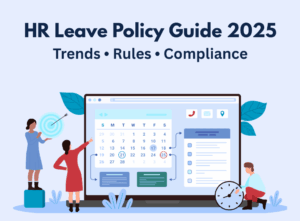Everyone in India knows how crucial the months of March and April are when it comes to finances and the economy of the country at large. The fiscal year in India starts on the 1st of April and ends on 31st March. From income tax filling to investment declaration, there is a lot that happens in the month of March and all most everyone is swamped with work, whether it is a banker who has to ensure a successful closing for her bank or a shopkeeper who has to check the inventory status of his shop. Everyone is left scrambling and finding the best ways to save up on their income taxes that are generally deducted from the salaries of the months of February and March while making sure that they have submitted all their investment documents to the human resources department of their organization. And the human resources department is one hell of a place to be at this time of the year with confused employees seeking out the answers for their queries from the human resources department.
But March and April do not bring just lots of paperwork and confusion in your life. They bring to something joyful and long-awaited too. Yes, the months of March-April is the annual appraisal season across the different sectors in the country. It is the season more awaited than the monsoon when the amount on your paycheck increases a bit and makes your smile a bit wider. This is the time when all the long hours at work and the unending reports seem worth the effort. If you have clocked all-nighters just to get that one promotion and pay hike, appraisal season is the time when your responsibility and hard work would be acknowledged and appreciated. When the higher authorities see your efforts and dedication towards your job, you may get a promotion too, on top of the salary increment!
While this is a time of joy and appreciation for a lot of employees, not all of them get to share the same feelings. Many employees feel that they were not given their due in terms of less percentage of increment in salary or missed promotion opportunities. This leads to the harboring of feelings of resentment, and many decide to resign from their respective positions in the company and look for greener pastures elsewhere. If you think this is a one-off case, you are mistaken. Statistics say that the attrition rates jump substantially after annual appraisals and salary hikes. In a survey conducted by a top recruitment agency, 62% of employees were keen on switching jobs post the appraisal season. Out of these, 64% of employees gave unsatisfactory appraisal as the reason for wanting to change their jobs while the rest of them wanted to milk the salary hike and get even better pay packages elsewhere. Especially in entry-level and mid-level positions, the employees are more inclined towards attrition as the number of opportunities is substantial and there are more chances of growth. But where does this leave an organization, with a high attrition rate and a number of unsatisfied employees? What exactly entails a successful appraisal? Where can the human resources department step in for a better outcome for both the employers and the employees?
What Is A Performance Appraisal?
A performance appraisal refers to the systematic evaluation process of an employee’s contribution and potential to the organization against pre-defined parameters. Alternatively called an annual performance review or employee assessment, it takes into account the job responsibilities of the employee and how the employee fares in her job role to ascertain her capabilities and future growth trajectory in the organization. Some of the factors that come into consideration during the performance appraisal of an employee are efficiency, quality, and quantity of work, attendance, leadership skills, judgment, co-operation, and teamwork to name a few.
A lot of emphases is put on an objective performance appraisal that evaluates employees critically without any bias for the betterment of both the employee and the employer, and rightly so. It gives key insights into how the employees are faring vis-à-vis their job roles. The main objectives of a performance appraisal are:
- Evaluation of the performance of the employees and feedback on the same
- Identification of the strengths of the employees to facilitate better utilization of their talents
- Identification of the weaknesses of the employees to provide training and development opportunities
- Identification of the right talent that can be groomed further to take leadership roles
- Promotion and salary hike for the deserving employees that have performed well
- Confirmation for the employees who have been on probation and have completed their probation period
- Effective communication between the employee and the employer with regards to KRAs and
- Database collection for compensation packages and wage structures
- Review and assessment of the ongoing training and development activities
These objectives can be attained only if a proper framework for a performance appraisal is implemented in the organization. While targets and plans can be measured and assessed objectively through numbers and charts, not the same can be said of the subjective parameters like attitude and leadership capabilities. This is where it gets tricky as many times, personal opinions and biases can affect the performance appraisal, intentionally and unintentionally. A performance appraisal is deemed successful when it can reduce subjectivity to the bare minimum without giving full focus to the objective factors. The balance is tricky but once you attain it, the reasons for undertaking such a comprehensive performance appraisal becomes clear.
Performance appraisals are generally done through the following two methods:
- Traditional methods of performance appraisal which include rating scales, checklists, forced choice, forced distribution, critical incident, performance test, and observation, field review, confidential record, essay method, comparative evaluation approaches, cost accounting method, and behaviorally anchored rating scales.
- Modern methods of performance appraisal which include 360-degree feedback, 720-degree feedback, management by objectives, psychological appraisal and assessment centers.
What Is Attrition Rate?
Attrition rate refers to the rate of employees leaving an organization in a specified period of time. Also known as the churn rate, this is used to determine an organization’s ability to retain its employees over a period of time. It is collocated by the following formula:
Attrition Rate (%) = (Number of separations/ Number of employees) * 100
Attrition can be voluntary i.e. resignations or involuntary such as lay-offs. Even retirement also comes under attrition but organizations are duly prepared in these cases with a succession plan. This ensures that retirement does not become a key concern for the organization. A high attrition rate for any organization is a warning sign as it indicates that a lot of employees are not satisfied with the organization’s way of functioning and may cast it in a poor light. The reasons can range from poor pay package and lack of growth opportunities to poor work-life balance and excessive work stress.
As organizations invest a lot of time, resources, and efforts in hiring and training the right people for a particular job, it is highly imperative that they actively work to reduce attrition rates to ensure that employees stay in the organizations for a considerable period of time. Taking corrective actions that lead to job satisfaction of the employees can reduce attrition rate significantly and would be a much cost-effective solution than hiring new people.
How To Reduce Attrition Rates After Appraisal Season
Performance appraisals are not easy for anyone who is involved in this as there are numerous methods to go through it and yet, there is not one best way yet. There are long feedback forms to be filled and even longer time to be spent in scrutinizing them. There are checklists that need to be ticked and rating scales that have to be rated and be rated upon on them. And yet, not everyone is happy at the end of the day even after all these efforts.
As companies focus on how to bring down the attrition rates after the appraisal, a lot of it depends on how the human resources department steps up to this challenge. If you already have a strong performance appraisal SOP in place that brings together the best of both the traditional and the modern methods of performance appraisal, it is half the battle won. For those who got a ‘below expectation’ performance appraisal, the challenge lies in getting their motivation level back up and removing any sort of hard feelings that they might harbor for the organization. These hard feelings and negative thoughts really hamper productivity at the workplace and can further affect the performance of the employee, culminating in a downward spiral that can only be broken by leaving the organization.
One way of retaining those employees who did not have favorable appraisals in terms of salary increment is by improving their work experience. If salary increment is not an option, consider improving the benefits and perks included with their salary package. It can be anything from flexible working hours and educational assistance to stock share in the company, extra paid leaves, and free lunch. It might cost the organization even less than a salary hike but it would show the employees that the organization cares and values them. This can go a long way in regaining the trust of the employees and in turn, retaining them.
Those who have been through a below expectations appraisal should be made to understand how the appraisal system works in a fair manner and where they have fallen short of the yardstick. Additionally, they should be presented with a Performance Improvement Plan (PIP) from their manager that outlines the specific job goals that needed to be fulfilled to achieve better performances and thus, rewards. Put the spotlight back on them by entrusting them with new challenges that can re-instate their faith in the management and the organization.
Providing the employees with re-skilling and training programmes will help them in further advancing their growth trajectory and thus, give them hope that a bad appraisal does not mean the end of the career. It will also indicate that this could be an excellent chance to improve and work on their professional skills to be the best version of themselves and grow professionally. Whether it is overseas exposure or a state-of-the-art training and development programme, employees love being challenged and thrown out of their comfort zone and this would be the best time to introduce these programmes and measures to boost up the morale of these employees.
When it comes to attrition, the human resources department would have to go the extra mile and reach out to all the employees on a one-to-one basis after the performance appraisal to give them reasons to stay in the organization. If even after your best efforts, an employee is not ready to stay, the HR department needs to understand that they cannot totally eliminate the attrition rate. They should make sure that their focus stays on the key employees who are essential to the organization. It is very important for them to distinguish between the key employees and the non-key employees as the strategy to retain them in both the cases differ from each other. For the key employees, the HR and the management can go out of their way to make sure that they stay back in the organization as hiring and training new talent would cost the organization a bomb and could still be a gamble. For the non-key employees, the human resources team can easily accept their decision of moving on from the organization to greener pastures as they are not critical to the functioning of the organization. The organization can afford to hire new talent and new people as the need may be.
At the end of the day, it all depends on what and how much an employee brings to the table.


